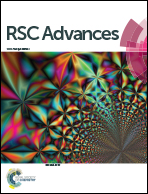Protic salt-based nitrogen-doped mesoporous carbon for simultaneous electrochemical detection of Cd(ii) and Pb(ii)
Abstract
Nitrogen-doped mesoporous carbon (NMC) derived from a single small-molecule protic salt (p-phenylenediamine bisulfate) is used for sensing toxic heavy metal ions. Using Nafion, bismuth and NMC to anchor the glassy carbon electrode surface, the fabricate electrode shows high sensitivity for detecting Cd(II) and Pb(II). The limits of detection (S/N = 3) are estimated to be 0.3 μg L−1 for Cd(II) and 0.4 μg L−1 for Pb(II), respectively, which are 10 and 25 times lower than the maximum acceptable content for drinking water recommended by the WHO. Furthermore, the sensor is successfully used to analyze Cd(II) and Pb(II) in tap-water with high anti-interference capability and good recovery.



 Please wait while we load your content...
Please wait while we load your content...